Science
How a water scientist hopes to save California habitats that could be pumped dry
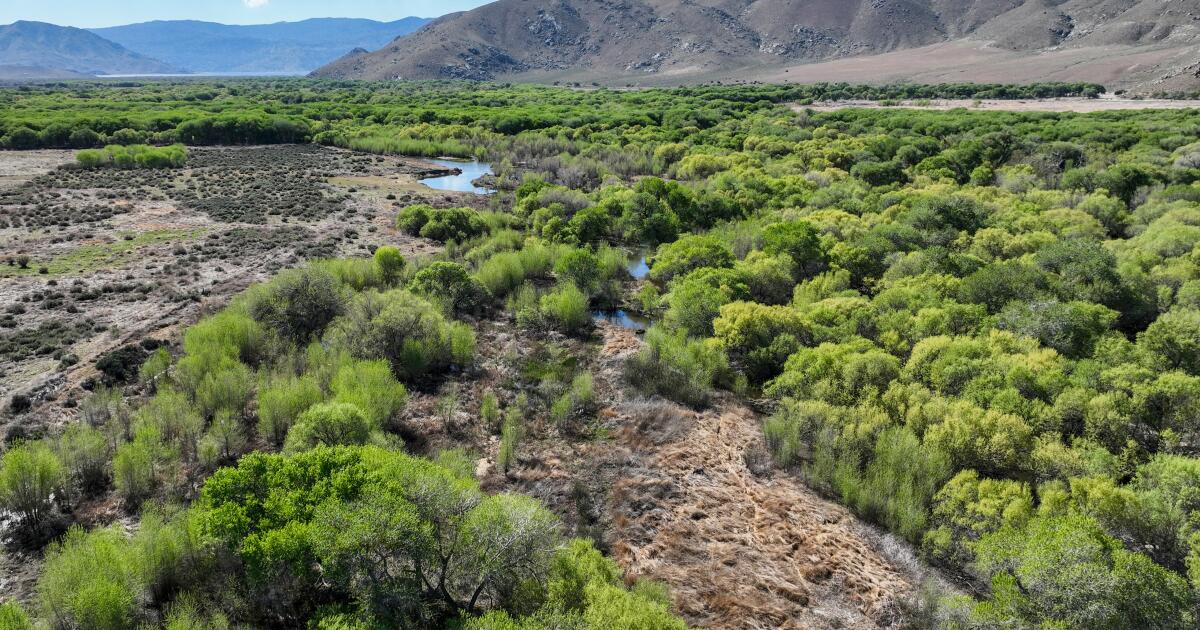
California is recognized as one of the world’s hotspots of biodiversity, with more species of plants and animals than any other state. And a significant number of the state’s species, from frogs to birds, live in habitats that depend on groundwater.
These rich ecosystems — including spring-fed streams, wetlands, riparian forests and oak woodlands — are vulnerable to declines in groundwater levels. In areas where unchecked pumping from wells severely depletes aquifers, once-thriving wetlands and forests can dry up and die.
Spotting threats to vulnerable natural areas has become a mission for Melissa Rohde, a hydrologist who has spent years analyzing satellite data and water levels in wells to come up with strategies for preventing ecosystems from being left high and dry.
“Nature has been getting the short end of the stick. It basically gets whatever is left behind, which oftentimes is not enough,” Rohde said. “How do we ensure that these ecosystems are protected?”
More than 300 species of birds have been seen at Kern River Preserve.
(Robert Gauthier / Los Angeles Times)
California is the only state with a groundwater law that includes provisions intended to protect groundwater-dependent ecosystems. But the law, adopted in 2014, gives considerable leeway to local agencies in developing water management plans that prevent “significant and unreasonable adverse impacts.”
When Rohde and other scientists examined the local plans for parts of the state that fall under regulation, they found only about 9% of groundwater-dependent ecosystems are adequately protected, while the remaining 91% are vulnerable.
When they looked at the entire state, they determined only 1% of the ecosystems are sufficiently protected under measures adopted to date.

Aggressive and impactful reporting on climate change, the environment, health and science.
Rohde has been focusing on finding ways to change that, in California and around the world.
Often working at home, she has pored over satellite data to spot decreases in vegetation greenness during drought, a telltale sign of die-off caused by declining aquifer levels. And she has analyzed how different types of trees, including willows, cottonwoods and oaks, fare when water levels fall depending on the depth of their roots.
Rohde and other researchers recently published a study outlining how California can set targets for maintaining groundwater levels — based on a formula including the type of vegetation, local water data and satellite imagery — to ensure the plants that anchor each ecosystem will be able to reach water and survive during dry times.
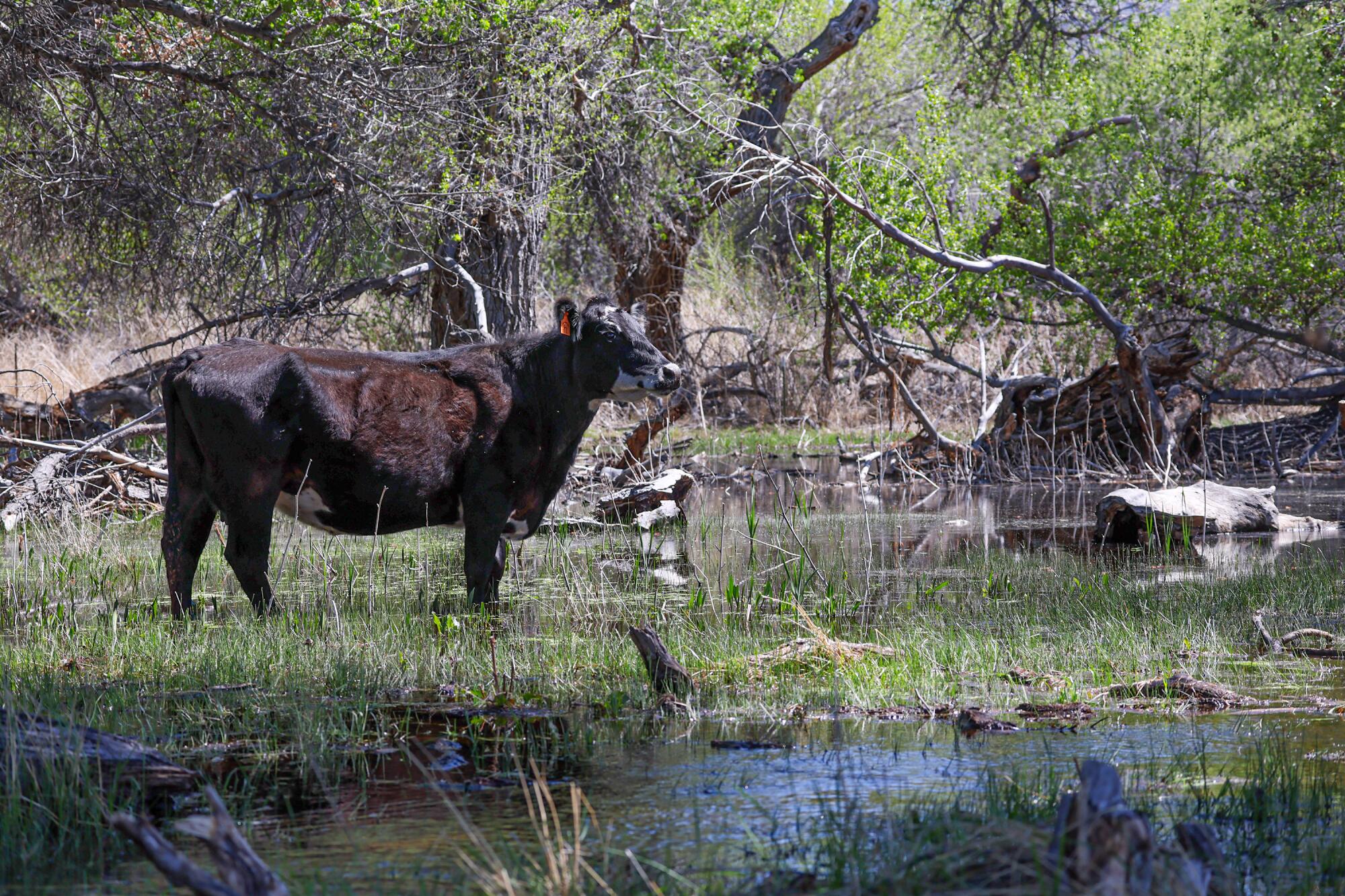
Cattle graze at the Kern River Preserve.
(Robert Gauthier / Los Angeles Times)
“If we don’t have groundwater levels that are able to support these diverse native vegetation ecosystems, then basically we run the risk of losing that important habitat for a lot of our threatened and endangered species,” Rohde said. “When you play around with keeping groundwater levels too deep to support the habitat, then you could lose species, and then that’s irreversible. The consequences can be severe.”
In California’s Mediterranean climate, trees, shrubs and the species they support are naturally adapted to drought. But excessive pumping from wells can push habitats beyond ecological limits by depleting the sources that sustain them.
With humanity’s heating of the planet intensifying droughts, the strains affecting these ecosystems continue to grow.
Already, California has lost the vast majority of its original wetlands to development, water diversions and agriculture. To avoid losing what remains, Rohde said, the state needs “a precautionary and preventative approach that can ensure that these ecosystems can withstand the intensification of droughts in climate change.”
During a recent visit to Kern County, Rohde and several conservation specialists walked in the shade through a lush forest of cottonwood trees near the south fork of the Kern River, visiting a nature preserve she had previously seen only in satellite images.
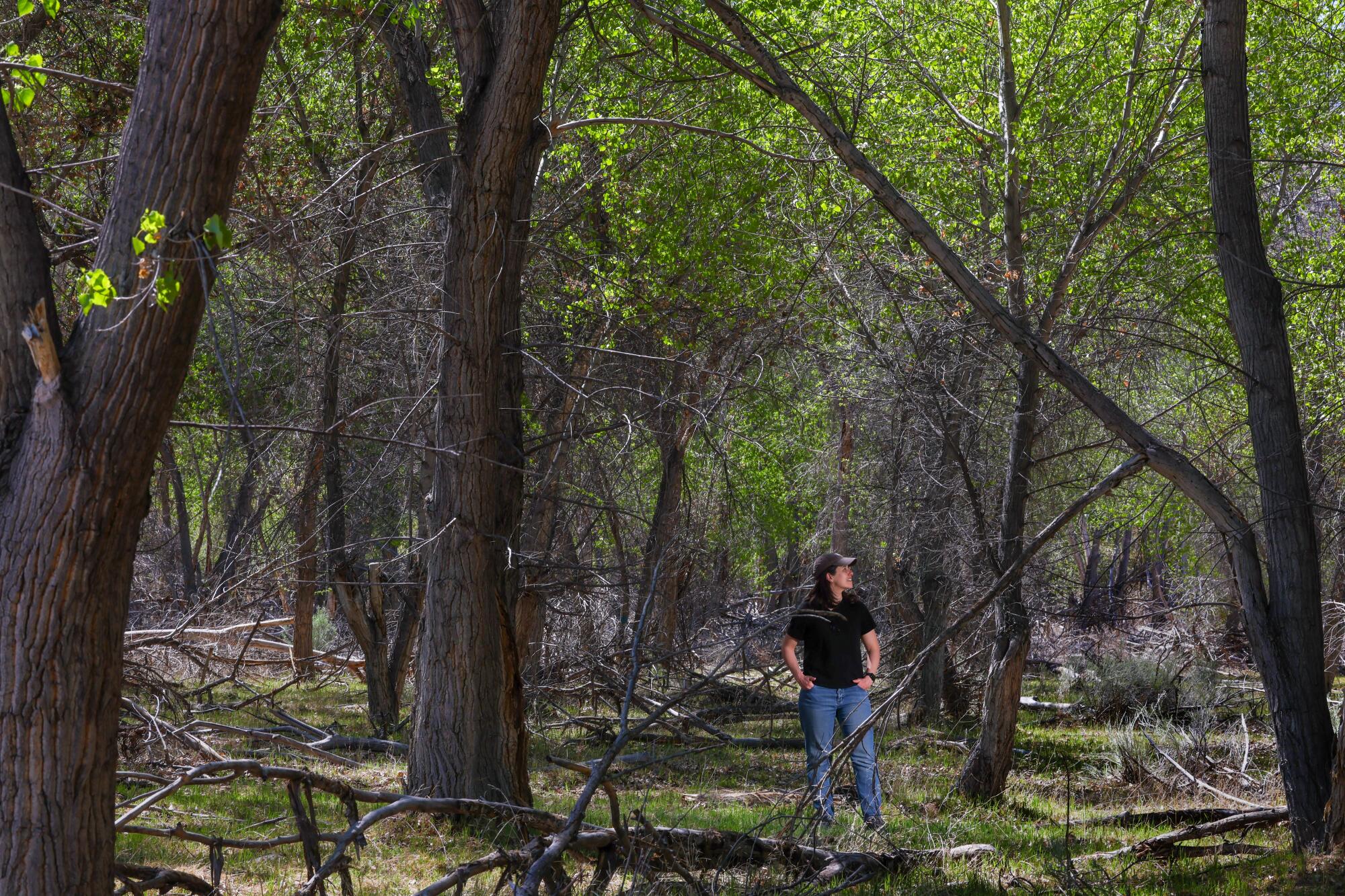
Scientist Melissa Rohde visits a riparian forest at the Kern River Preserve.
(Robert Gauthier / Los Angeles Times)
At the edge of a clearing, she came upon the bare, sunbleached skeletons of dead trees.
She said satellite data had revealed that parts of the forest died along this part of the Kern River during the drought between 2012 and 2016.
“That’s because the groundwater levels rapidly declined,” Rohde said.
After that die-off, she said, groundwater levels rebounded in the area, and the native vegetation has been growing back.
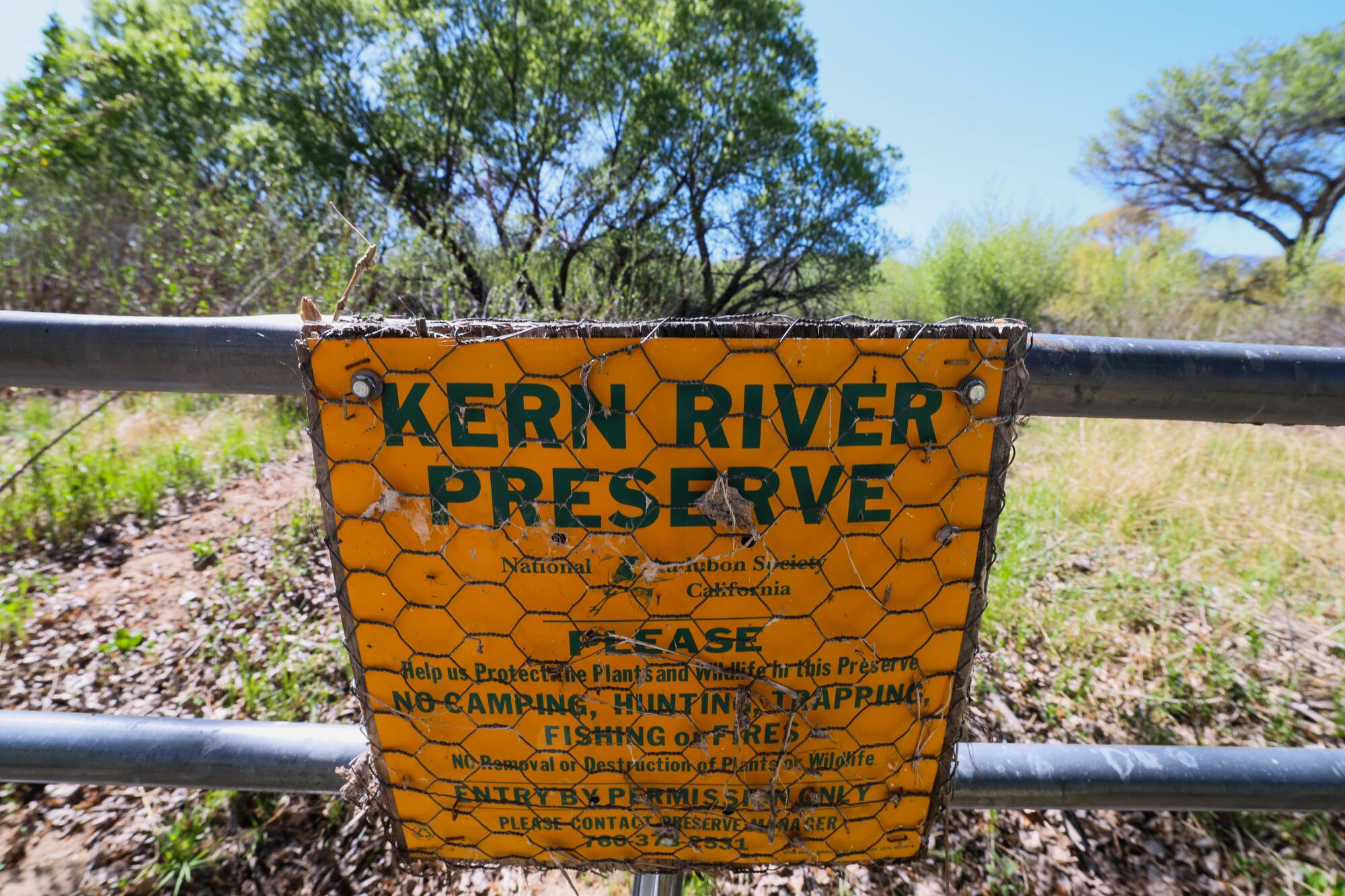
The Kern River Preserve protects the riparian ecosystem along the south fork of the Kern River.
(Robert Gauthier / Los Angeles Times)
It helps that this forest is protected as part of the Kern River Preserve, which is managed by the National Audubon Society, and that some nearby farmlands have been retired and converted to conservation lands over the years.
The preserve’s managers, working with the organization Ducks Unlimited, have also restored an expanded wetland by diverting water from the river and flooding a section of pastureland where cattle used to graze.
The wetland attracts birds, such as coots and tricolored blackbirds, and also recharges the aquifer that the roots of cottonwoods and willows tap into.
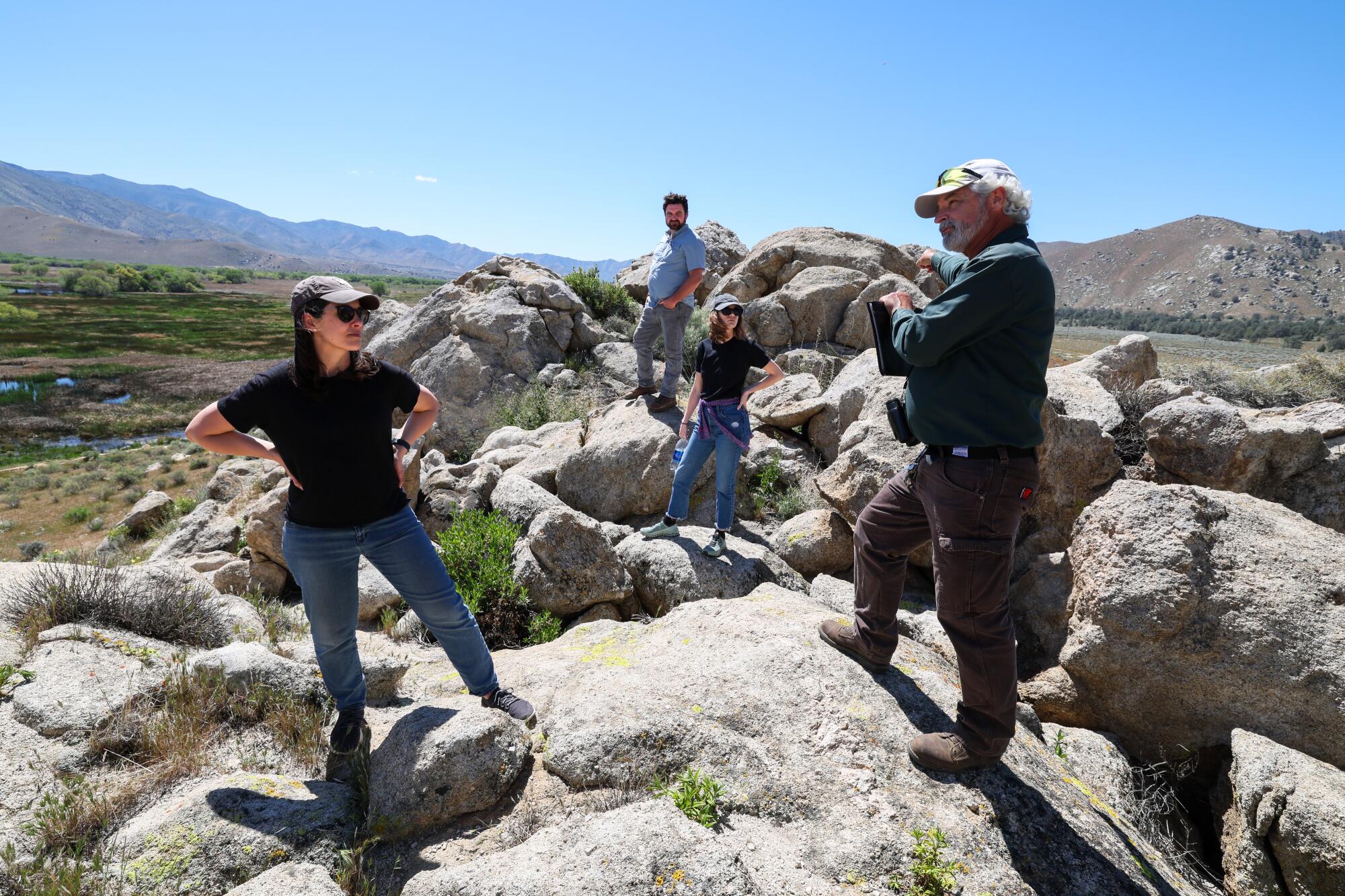
Scientist Melissa Rohde, left, and conservation specialists from Ducks Unlimited and the Audubon Society, including Reed Tollefson, right, stand on rocks overlooking a wetland at the Kern River Preserve.
(Robert Gauthier / Los Angeles Times)
The 3,300-acre preserve has expanded as adjacent alfalfa fields have been purchased and agricultural wells have been shut down, said Reed Tollefson, the preserve’s manager. These efforts have helped protect a refuge for birds including willow flycatchers and yellow-billed cuckoos.
As he pointed to several dead trees poking from the living cottonwoods, he said protecting the forest from groundwater pumping and climate change will require additional effort.
“I think it’s tenuous,” he said. “We’ve got more work to do to try and really sustain this.”
The dead trees that have appeared here and elsewhere in California over the past decade represent the sort of die-off that water managers need to focus on preventing, Rohde said.
“It has to be an intentional practice of setting thresholds, monitoring, using satellite data or other scalable means to measure the impacts, in order to make sure that we are not allowing this to happen on a wider scale,” she said. “From a biodiversity perspective, it’s absolutely critical.”
Rohde said she felt hopeful seeing the forest rebounding and much greener than it was several years ago, with many young trees coming up.
Some other parts of California haven’t fared nearly as well.
One rainy day last month, Rohde visited an area along the Santa Clara River in Ventura County where several hundred acres of willows and cottonwoods dried up and died during the drought in the mid-2010s.
When groundwater pumping by farms and communities caused aquifer levels to fall, many trees died along the river near the city of Fillmore.
“We saw this catastrophic drop in groundwater at this site,” Rohde said.
She visited the area with a research colleague and two managers from The Nature Conservancy. They stood on a gravel road next to a lemon grove, checking on what remained of the forest.
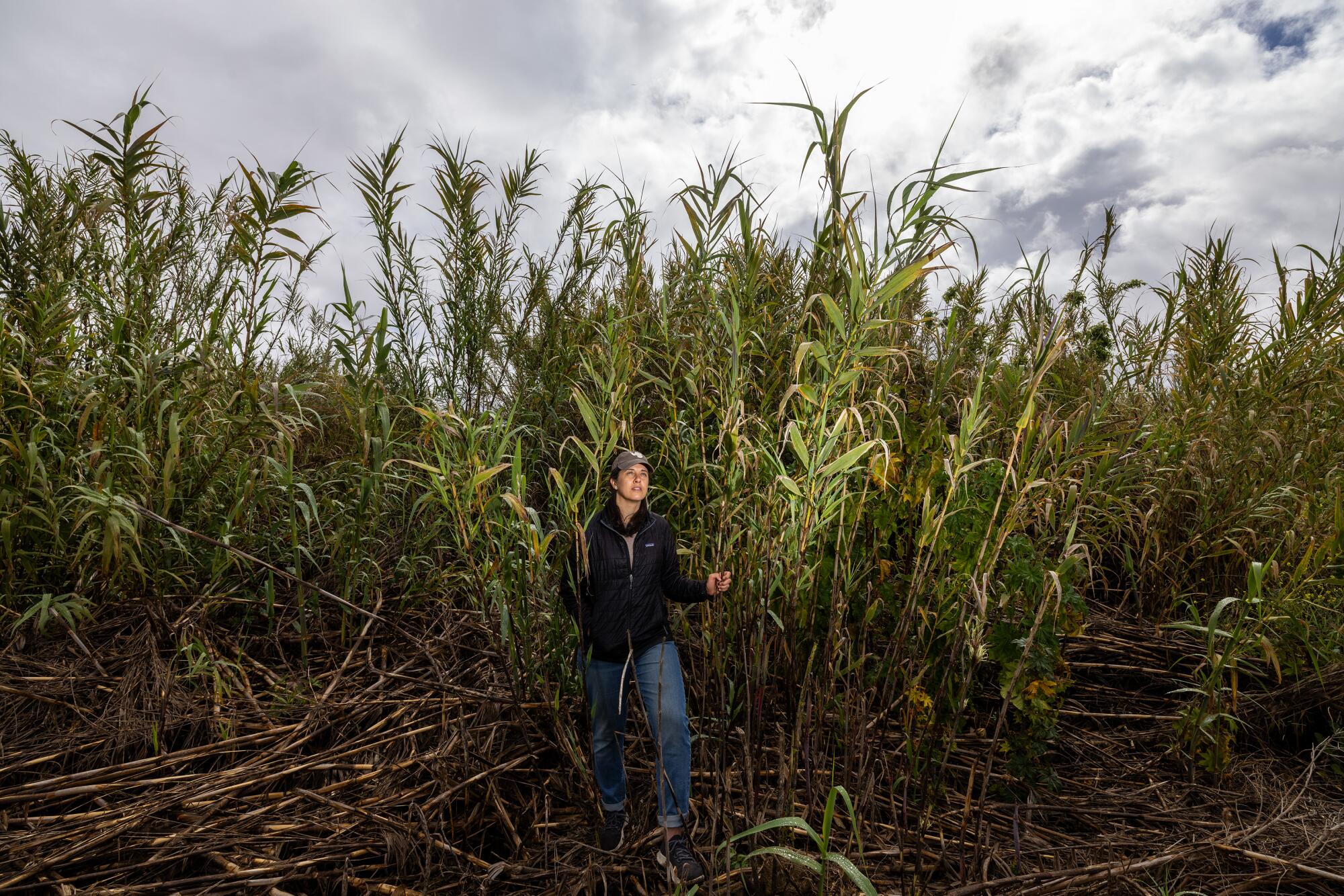
Scientist Melissa Rohde stands in a thicket of arundo, an invasive reed that has proliferated along parts of the Santa Clara River in Ventura County. There are ongoing efforts to remove the nonnative reeds in the area.
(Brian van der Brug / Los Angeles Times)
Where native trees died, an explosion of invasive reeds has taken over. The nonnative reeds, called arundo, have grown into thickets more than 20 feet tall. And unlike willows, Rohde said, arundo offers little value as habitat for birds.
“When we had that massive die-off, and the groundwater levels remained deep, there was no way for the native vegetation to regenerate,” she said. “But arundo is extremely efficient at extracting soil moisture. And so it was able to outcompete the native vegetation.”
She said efforts to prevent this sort of habitat degradation should be prioritized.
When managers of local agencies set goals for maintaining groundwater levels, she said, they can tailor targets to the type of vegetation — whether there are cottonwood trees, with roots averaging about 9 feet long, or oaks, with roots that average nearly 30 feet but can grow much deeper.
Her colleague Michael Bliss Singer said when native trees are ravaged by multiple years of low water levels, they will start losing leaves and then dropping branches.
In one study, Singer and others documented a “brown wave” of trees drying along the Santa Clara River between 2012 and 2016 — a loss they saw in satellite images.
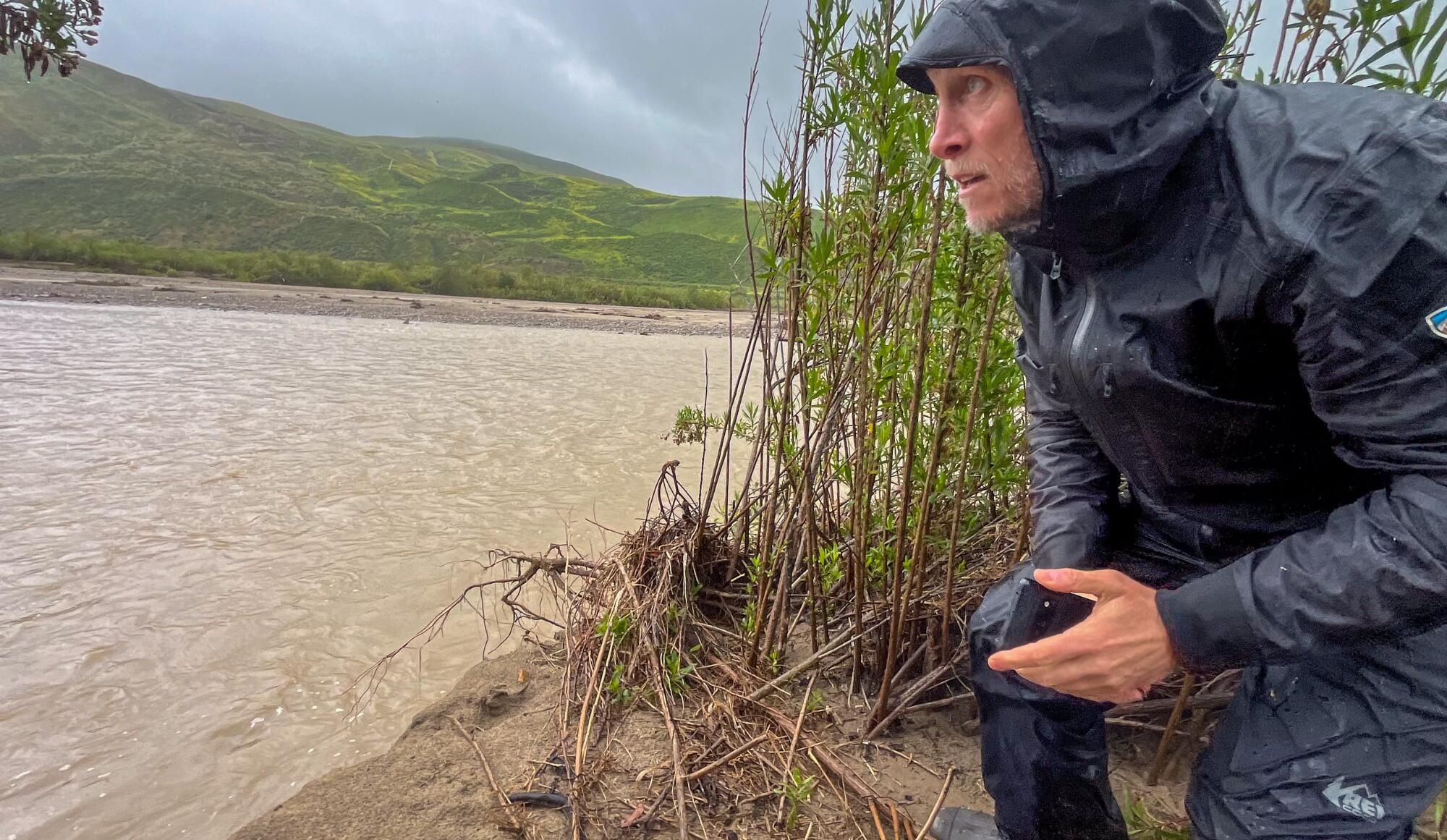
Scientist Michael Bliss Singer looks out over the Santa Clara River in Ventura County.
(Brian van der Brug / Los Angeles Times)
“It’s completely transformed the ecosystem here,” said Singer, a professor at Cardiff University in Wales who is also a researcher at UC Santa Barbara.
When plants die off like this and don’t recover, it’s a symptom of an ecosystem in decline. To prevent more of these losses in an era when climate change is driving more severe droughts, Singer said, it’s crucial to “come up with creative solutions for the worst-case scenario.”
Rohde has found in her research, however, that most local groundwater plans in California haven’t adequately accounted for climate projections.
Previously, Rohde did other types of climate research, including a stint in Antarctica in 2010, where she was part of a drilling team collecting ice cores. From that experience, Rohde said she realized that “I didn’t want to spend my career convincing people that climate change was an issue; I wanted to do something about it.”
She wore a faded cap with an Antarctica map, a memento of that trip. Rohde said her recent work is motivated by concerns about the climate crisis and biodiversity, as well as a conviction that proactive steps to protect ecosystems can make a difference.
“I have two young kids. I really want to make sure that I’m doing the best thing that I can to ensure a sustainable future for them, where they can access nature,” Rohde said.

E.J. Remson, a senior project director for The Nature Conservancy, surveys a wetland along the Santa Clara River in Ventura County.
(Brian van der Brug / Los Angeles Times)
“Often groundwater is out of sight, out of mind,” she said. “We don’t measure it, we don’t understand it and we misuse it. And we need to make sure that we are managing groundwater so that it is supporting us, and making sure that we have a sustainable future.”
Rohde now works as an independent scientist. Previously, as a researcher for The Nature Conservancy, she helped write an atlas of threatened and endangered species that rely on groundwater.
California’s groundwater-dependent ecosystems lie not only along streams, but also in habitats such as mountain meadows, coastal redwood forests and mesquite bushes among desert sand dunes. The species they support range from tiger salamanders to desert pupfish, and from songbirds to mammals such as ground squirrels and bighorn sheep.
“The risks are high when species are on the verge of extinction,” Rohde said.
Rohde and other scientists have found that ecosystems sustained by groundwater are under threat worldwide. Some of the few regions that have measures intended to protect them, she said, include Australia, the European Union and California.
Still, even with California’s groundwater regulations and endangered species laws, Rohde said, “we continue to miss the mark in actually protecting them.”
Rohde said state officials should give local water agencies clear direction to ensure they’re using science-based methods to safeguard ecosystems in their state-mandated plans. She said agencies can now use the approaches scientists have outlined to map strongholds of biodiversity and set targets for maintaining aquifer levels.
“It’s very attainable,” she said. “Now, it’s just basically up to political will, or enforcement by the Department of Water Resources, to ensure that that happens.”
Walking in the rain at the Santa Clara River Preserve, Rohde followed her former Nature Conservancy colleagues Peter Dixon and E.J. Remson on a trail through a stand of healthy trees.

Peter Dixon, a project manager with The Nature Conservancy, walks on a trail through the riparian forest at the Santa Clara River Preserve.
(Brian van der Brug / Los Angeles Times)
They stood on the banks of the fast-flowing river, watching the muddy water churn past.
In the summer and fall, this part of the river usually dwindles to a trickle.
And during the next drought, when the river dries up, the forest will depend on the same groundwater that nearby communities and farms also use.
If the water needs of this and other ecosystems aren’t prioritized, Rohde said, vital habitats will suffer.
“We need to be deliberate about the planning, and ensuring that they get their fair share,” she said. “Their existence is potentially imperiled if we don’t act.”

Science
Trump administration declares ‘war on sugar’ in overhaul of food guidelines

The Trump administration announced a major overhaul of American nutrition guidelines Wednesday, replacing the old, carbohydrate-heavy food pyramid with one that prioritizes protein, healthy fats and whole grains.
“Our government declares war on added sugar,” Health and Human Services Secretary Robert F. Kennedy Jr. said in a White House press conference announcing the changes. “We are ending the war on saturated fats.”
“If a foreign adversary sought to destroy the health of our children, to cripple our economy, to weaken our national security, there would be no better strategy than to addict us to ultra-processed foods,” Kennedy said.
Improving U.S. eating habits and the availability of nutritious foods is an issue with broad bipartisan support, and has been a long-standing goal of Kennedy’s Make America Healthy Again movement.
During the press conference, he acknowledged both the American Medical Association and the American Assn. of Pediatrics for partnering on the new guidelines — two organizations that earlier this week condemned the administration’s decision to slash the number of diseases that U.S. children are vaccinated against.
“The American Medical Association applauds the administration’s new Dietary Guidelines for spotlighting the highly processed foods, sugar-sweetened beverages, and excess sodium that fuel heart disease, diabetes, obesity, and other chronic illnesses,” AMA president Bobby Mukkamala said in a statement.
Science
Contributor: With high deductibles, even the insured are functionally uninsured

I recently saw a patient complaining of shortness of breath and a persistent cough. Worried he was developing pneumonia, I ordered a chest X-ray — a standard diagnostic tool. He refused. He hadn’t met his $3,000 deductible yet, and so his insurance would have required him to pay much or all of the cost for that scan. He assured me he would call if he got worse.
For him, the X-ray wasn’t a medical necessity, but it would have been a financial shock he couldn’t absorb. He chose to gamble on a cough, and five days later, he lost — ending up in the ICU with bilateral pneumonia. He survived, but the cost of his “savings” was a nearly fatal hospital stay and a bill that will quite likely bankrupt him. He is lucky he won’t be one of the 55,000 Americans to die from pneumonia each year.
As a physician associate in primary care, I serve as a frontline witness to this failure of the American approach to insurance. Medical professionals are taught that the barrier to health is biology: bacteria, viruses, genetics. But increasingly, the barrier is a policy framework that pressures insured Americans to gamble with their lives. High-deductible health plans seem affordable because their monthly premiums are lower than other plans’, but they create perverse incentives by discouraging patients from seeking and accepting diagnostics and treatments — sometimes turning minor, treatable issues into expensive, life-threatening emergencies. My patient’s gamble with his lungs is a microcosm of the much larger gamble we are taking with the American public.
The economic theory underpinning these high deductibles is known as “skin in the game.” The idea is that if patients are responsible for the first few thousand dollars of their care, they will become savvy consumers, shopping around for the best value and driving down healthcare costs.
But this logic collapses in the exam room. Healthcare is not a consumer good like a television or a used car. My patient was not in a position to “shop around” for a cheaper X-ray, nor was he qualified to determine if his cough was benign or deadly. The “skin in the game” theory assumes a level of medical literacy and market transparency that simply doesn’t exist in a moment of crisis. You can compare the specs of two SUVs; you cannot “shop around” for a life-saving diagnostic while gasping for air.
A 2025 poll from the Kaiser Family Foundation points to this reality, finding that up to 38% of insured American adults say they skipped or postponed necessary healthcare or medications in the past 12 months because of cost. In the same poll, 42% of those who skipped care admitted their health problem worsened as a result.
This self-inflicted public health crisis is set to deteriorate further. The Congressional Budget Office estimates roughly 15 million people will lose health coverage and become uninsured by 2034 because of Medicaid and Affordable Care Act marketplace cuts. That is without mentioning the millions more who will see their monthly premiums more than double if premium tax credits are allowed to expire. If that happens, not only will millions become uninsured but also millions more will downgrade to “bronze” plans with huge deductibles just to keep their premiums affordable. We are about to flood the system with “insured but functionally uninsured” patients.
I see the human cost of this “functional uninsurance” every week. These are patients who technically have coverage but are terrified to use it because their deductibles are so large they may exceed the individuals’ available cash or credit — or even their net worth. This creates a dangerous paradox: Americans are paying hundreds of dollars a month for a card in their wallet they cannot afford to use. They skip the annual physical, ignore the suspicious mole and ration their insulin — all while technically insured. By the time they arrive at my clinic, their disease has often progressed to a catastrophic event, from what could have been a cheap fix.
Federal spending on healthcare should not be considered charity; it is an investment in our collective future. We cannot expect our children to reach their full potential or our workforce to remain productive if basic healthcare needs are treated as a luxury. Inaction by Congress and the current administration to solve this crisis is legislative malpractice.
In medicine, we are trained to treat the underlying disease, not just the symptoms. The skipped visits and ignored prescriptions are merely symptoms; the disease is a policy framework that views healthcare as a commodity rather than a fundamental necessity. If we allow these cuts to proceed, we are ensuring that the American workforce becomes sicker, our hospitals more overwhelmed and our economy less resilient. We are walking willingly into a public health crisis that is entirely preventable.
Joseph Pollino is a primary care physician associate in Nevada.
Insights
L.A. Times Insights delivers AI-generated analysis on Voices content to offer all points of view. Insights does not appear on any news articles.
Viewpoint
Perspectives
The following AI-generated content is powered by Perplexity. The Los Angeles Times editorial staff does not create or edit the content.
Ideas expressed in the piece
-
High-deductible health plans create a barrier to necessary medical care, with patients avoiding diagnostics and treatments due to out-of-pocket cost concerns[1]. Research shows that 38% of insured American adults skipped or postponed necessary healthcare or medications in the past 12 months because of cost, with 42% reporting their health worsened as a result[1].
-
The economic theory of “skin in the game”—which assumes patients will shop around for better healthcare values if they have financial responsibility—fails in medical practice because patients lack the medical literacy to make informed decisions in moments of crisis and cannot realistically compare pricing for emergency or diagnostic services[1].
-
Rising deductibles are pushing enrollees toward bronze plans with deductibles averaging $7,476 in 2026, up from the average silver plan deductible of $5,304[1][4]. In California’s Covered California program, bronze plan enrollment has surged to more than one-third of new enrollees in 2026, compared to typically one in five[1].
-
Expiring federal premium tax credits will more than double out-of-pocket premiums for ACA marketplace enrollees in 2026, creating an expected 75% increase in average out-of-pocket premium payments[5]. This will force millions to either drop coverage or downgrade to bronze plans with massive deductibles, creating a population of “insured but functionally uninsured” people[1].
-
High-deductible plans pose particular dangers for patients with chronic conditions, with studies showing adults with diabetes involuntarily switched to high-deductible plans face 11% higher risk of hospitalization for heart attacks, 15% higher risk for strokes, and more than double the likelihood of blindness or end-stage kidney disease[4].
Different views on the topic
-
Expanding access to health savings accounts paired with bronze and catastrophic plans offers tax advantages that allow higher-income individuals to set aside tax-deductible contributions for qualified medical expenses, potentially offsetting higher out-of-pocket costs through strategic planning[3].
-
Employers and insurers emphasize that offering multiple plan options with varying deductibles and premiums enables employees to select plans matching their individual needs and healthcare usage patterns, allowing those who rarely use healthcare to save money through lower premiums[2]. Large employers increasingly offer three or more medical plan choices, with the expectation that employees choosing the right plan can unlock savings[2].
-
The expansion of catastrophic plans with streamlined enrollment processes and automatic display on HealthCare.gov is intended to make affordable coverage more accessible for certain income groups, particularly those above 400% of federal poverty level who lose subsidies[3].
-
Rising healthcare costs, including specialty drugs and new high-cost cell and gene therapies, are significant drivers requiring premium increases regardless of plan design[5]. Some insurers are managing affordability by discontinuing costly coverage—such as GLP-1 weight-loss medications—to reduce premium rate increases for broader plan members[5].
Science
Trump administration slashes number of diseases U.S. children will be regularly vaccinated against

The U.S. Department of Health and Human Services announced sweeping changes to the pediatric vaccine schedule on Monday, sharply cutting the number of diseases U.S. children will be regularly immunized against.
Under the new guidelines, the U.S. still recommends that all children be vaccinated against measles, mumps, rubella, polio, pertussis, tetanus, diphtheria, Haemophilus influenzae type B (Hib), pneumococcal disease, human papillomavirus (HPV) and varicella, better known as chickenpox.
Vaccines for all other diseases will now fall into one of two categories: recommended only for specific high-risk groups, or available through “shared clinical decision-making” — the administration’s preferred term for “optional.”
These include immunizations for hepatitis A and B, rotavirus, respiratory syncytial virus (RSV), bacterial meningitis, influenza and COVID-19. All these shots were previously recommended for all children.
Insurance companies will still be required to fully cover all childhood vaccines on the CDC schedule, including those now designated as optional, according to the Department of Health and Human Services.
Health Secretary Robert F. Kennedy Jr., a longtime vaccine critic, said in a statement that the new schedule “protects children, respects families, and rebuilds trust in public health.”
But pediatricians and public health officials widely condemned the shift, saying that it would lead to more uncertainty for patients and a resurgence of diseases that had been under control.
“The decision to weaken the childhood immunization schedule is misguided and dangerous,” said Dr. René Bravo, a pediatrician and president of the California Medical Assn. “Today’s decision undermines decades of evidence-based public health policy and sends a deeply confusing message to families at a time when vaccine confidence is already under strain.”
The American Academy of Pediatrics condemned the changes as “dangerous and unnecessary,” and said that it will continue to publish its own schedule of recommended immunizations. In September, California, Oregon, Washington and Hawaii announced that those four states would follow an independent immunization schedule based on recommendations from the AAP and other medical groups.
The federal changes have been anticipated since December, when President Trump signed a presidential memorandum directing the health department to update the pediatric vaccine schedule “to align with such scientific evidence and best practices from peer, developed countries.”
The new U.S. vaccination guidelines are much closer to those of Denmark, which routinely vaccinates its children against only 10 diseases.
As doctors and public health experts have pointed out, Denmark also has a robust system of government-funded universal healthcare, a smaller and more homogenous population, and a different disease burden.
“The vaccines that are recommended in any particular country reflect the diseases that are prevalent in that country,” said Dr. Kelly Gebo, dean of the Milken Institute School of Public Health at George Washington University. “Just because one country has a vaccine schedule that is perfectly reasonable for that country, it may not be at all reasonable” elsewhere.
Almost every pregnant woman in Denmark is screened for hepatitis B, for example. In the U.S., less than 85% of pregnant women are screened for the disease.
Instead, the U.S. has relied on universal vaccination to protect children whose mothers don’t receive adequate care during pregnancy. Hepatitis B has been nearly eliminated in the U.S. since the vaccine was introduced in 1991. Last month, a panel of Kennedy appointees voted to drop the CDC’s decades-old recommendation that all newborns be vaccinated against the disease at birth.
“Viruses and bacteria that were under control are being set free on our most vulnerable,” said Dr. James Alwine, a virologist and member of the nonprofit advocacy group Defend Public Health. “It may take one or two years for the tragic consequences to become clear, but this is like asking farmers in North Dakota to grow pineapples. It won’t work and can’t end well.”
-

 Detroit, MI5 days ago
Detroit, MI5 days ago2 hospitalized after shooting on Lodge Freeway in Detroit
-

 Technology3 days ago
Technology3 days agoPower bank feature creep is out of control
-

 Dallas, TX4 days ago
Dallas, TX4 days agoDefensive coordinator candidates who could improve Cowboys’ brutal secondary in 2026
-

 Health5 days ago
Health5 days agoViral New Year reset routine is helping people adopt healthier habits
-

 Nebraska2 days ago
Nebraska2 days agoOregon State LB transfer Dexter Foster commits to Nebraska
-

 Iowa2 days ago
Iowa2 days agoPat McAfee praises Audi Crooks, plays hype song for Iowa State star
-

 Nebraska2 days ago
Nebraska2 days agoNebraska-based pizza chain Godfather’s Pizza is set to open a new location in Queen Creek
-

 Entertainment2 days ago
Entertainment2 days agoSpotify digs in on podcasts with new Hollywood studios


















